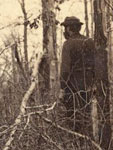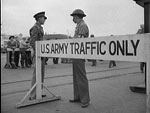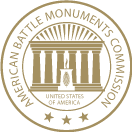This is the fourth in a series of film reviews reprinted from the Journal of American History. These reviews model ways of looking critically at popular films, documentaries, miniseries, and other history-based features.
Long awaited by both historians and buffs, the film Gods and Generals is a prequel to the 1993 film Gettysburg. As Gettysburg was based on the historical novel The Killer Angels (1974) by Michael Shaara, so Gods and Generals is based on the 1998 historical novel of that title written by Shaara's son Jeff. The new film's purpose is to sketch highlights of the Civil War in the eastern theater from Virginia's secession through the death of the Confederate general Thomas J. "Stonewall" Jackson.
The need to set the stage for Gettysburg influenced the choice of what to cover in the almost four-hour-long prequel. For example, Gods and Generals covers the battle of Fredericksburg while entirely omitting the much more pivotal battle of Antietam. This omission occurs in part because Fredericksburg was the first combat experience of the key Gettysburg protagonist, Joshua Lawrence Chamberlain, and because it was the event for which the Union repulse of Pickett's charge at Gettysburg was a suitable payback. One suspects that another reason the film skips Antietam is that it led to Abraham Lincoln's issuing the Emancipation Proclamation; coverage of that document might have led viewers to suspect that the war had something to do with slavery. Of this, more anon.
Actors still deliver, in spoken form, lines that their characters composed for written communication, making some scenes even more stilted than the 19th century actually was.
Like the Civil War soldiers it depicts, the film Gods and Generals has its triumphs and its defeats. In some ways it is an improvement over Gettysburg. Robert Duvall's portrayal of Robert E. Lee is infinitely superior to Martin Sheen's glassy-eyed performance in the earlier film. The makeup is better, too, so that the viewer does not see what appear to be beavers clinging to generals' chins, as in Gettysburg. And the artillery pieces actually recoil when fired.
On the other hand, Gods and Generals perpetuates some of its predecessor's weaknesses. Actors still deliver, in spoken form, lines that their characters composed for written communication, making some scenes even more stilted than the 19th century actually was. Other scenes have the feel of that favored entertainment of the mid-Victorians, the tableau vivant—but not very vivant. Sometimes it is like watching an animated wax museum.
The greatest triumph of Gods and Generals lies in Stephen Lang's splendid depiction of Stonewall Jackson. It is difficult to imagine a more authentic and convincing presentation of the renowned general. Eschewing popular mythology that makes Jackson a wild-eyed maniac, Lang presents an understandable character that is, in almost every case, true to what we know about Jackson. This is important to Gods and Generals because Jackson's role looms so large that the film might more accurately have been titled simply Stonewall Jackson.
When they wanted to do so, the makers of Gods and Generals were accurate in both detail and nuance. Unfortunately, the filmmakers preferred to spend much of the nearly four-hour running time of the movie doing a great deal of ax-grinding. The result is the most pro-Confederate film since Birth of a Nation, a veritable celluloid celebration of slavery and treason.
Gods and Generals brings to the big screen the major themes of Lost Cause mythology that professional historians have been working for half a century to combat. In the world of Gods and Generals, slavery has nothing to do with the Confederate cause. Instead, the Confederates are nobly fighting for, rather than against, freedom, as viewers are reminded again and again by one white southern character after another.
Gods and Generals brings to the big screen the major themes of Lost Cause mythology that professional historians have been working for half a century to combat.
In stark contrast, the pro-Union, antislavery view of the war is expressed only once. In one example of this unequal presentation, viewers hear the Confederate defenders of the famous sunken lane at Fredericksburg exclaiming that they are fighting for freedom and independence, but the Union attackers, members of the renowned Irish Brigade, make only trivial comments. Yet historical sources document in the Irishmen's own eloquent words why they, as immigrants, believed they ought to fight for the Union. The filmmakers did not see fit to have any of the actors mouth those lines.
Similarly, the film depicts slaves as generally happy, vaguely desiring freedom at some future date, but faithful and supportive of their beloved masters and the cause of the Confederacy. Slaveholders in the film treat their slaves like family or better, and the slaves reciprocate by doing their best to protect their masters' property from the invading Yankees. The many thousand times more numerous slaves who eagerly sought freedom and aided Union soldiers are invisible in Gods and Generals.
Another aspect of Lost Cause mythology depicted in the film deals with religion. Echoing pro-Confederate claims since the war itself, the movie represents the South as being uniquely and sincerely Christian, while the North has at most a vague spirituality. In fact, both sides had about an equal representation of Christianity. Once again, Gods and Generals presents a skewed depiction of history through judicious omission. While the film—for the most part accurately—presents Stonewall Jackson as a saint in every sense of the word, viewers never learn that Oliver O. Howard, the Union general whose troops Jackson's men so savagely attacked at Chancellorsville, was an even more fervently evangelical soldier.
Jackson's attack at Chancellorsville is the dramatic climax to the film and a neo-Confederate's dream of paradise. As Jackson rides boldly forward flanked by staff officers, the mounted party gallops toward the viewer, larger than life, and the score swells, simultaneously triumphant and otherworldly, a fittingly Wagnerian style of accompaniment for this ride of the Confederate valkyries. Any lingering doubts as to the filmmakers' sympathies promptly vanish.
The final scene at Jackson's deathbed is meant to be sad, and it is indeed very moving. Yet I left the showing quite sad in a different way. Despite the makers' large expenditures and serious efforts toward accuracy in some details, they marred the result by their willingness to perpetuate a distorted view of the Civil War.





